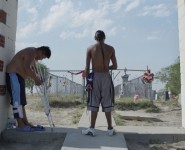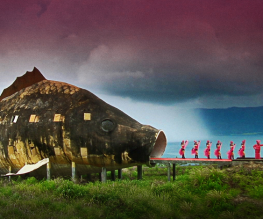Bomb It

Bomb It begins with a lesson in graffiti history, chronicling the subculture’s origins in late 60s Philadelphia and its gradual development through the 70s and 80s on New York City subway system. This historical account doesn’t rival that given by the seminal Style Wars (1984), but it still presents a pretty good sketch of the era, and anyone who already knows their graffiti history will still no doubt enjoy listening to the old-timers they have managed to track down for interviews. It’s an impressive roster which features Cornbread, Taki138, Tracy, Pink and legendary subterranean storyteller Revs, amongst many others. However it’s not all wistful reminiscing, and as well some reflection on the social issues which plagued 70/80s New York, there is also sense of deep regret over what areas of the city have since become: whitewashed playgrounds for the rich.
To develop these socio-political ideas director Jon Reiss leaves America and embarks on a survey of world graffiti, stopping off at Paris, Berlin, Barcelona, Cape Town, Tokyo and São Paulo before arriving back in LA. This trip round the world documents not only the various different styles, but also the attitudes towards graffiti and, most interestingly, the attitudes of the artists themselves – why they write their names on walls, legally or illegally. Often the rationale is one of brotherhood – a marginalised, disenfranchised youth ignored by society, whether it’s the French Arabs in the Parisian suburbs or the ‘coloureds’ of Cape Town who fell into the social limbo created by South African apartheid. Echoes of 1970s New York develop as a common theme, but the film also features the work of artists from other social demographics. From German graphic designers painting 90ft murals to middle-aged mothers in Tokyo, it feels like Reiss has made a conscious effort to demonstrate not only the diversity but the ubiquity of graffiti culture.

Despite the global diversity there is one thing that all these acts of exterior decorating share – they all challenge notions of public space. This fact is used to bring the seemingly disparate elements of graffiti culture together when, in final leg of the trip, the focus is turned back to the Americas.
Travelling to Brazil Reiss meets the Pixadores of São Paulo, whose lanky and uniquely stylised fonts daub even the tallest peaks of the urban skyline. However, these all too brief sequences represent a missed opportunity. Not only does the Pixadores’ ‘pixação’ style technically predate modern graffiti, but in 2007 (shortly after filming) their city became the first non-communist authority to ban outdoor public advertising. Neither the important history of Sao Paulo nor the radical future it had plotted is discussed, and both would undoubtedly have greatly added to the critical thrust of the film. Still, the political and social commentary is present, and is given a little more bite in the DVD extras which feature an interesting discussion with Reiss himself and a fascinating extended interview with graffiti writer turned geography academic Stefano E Bloch.

Bomb It is an ambitious film – you could in fact say that it is too ambitious. In offering an impressively diverse survey of world graffiti it neglects to fully develop the many issues it touches upon. Amongst these are not just the ownership of public space but also the unique relation of graffiti (as an art object) to capital, and similarly the relation of graffiti to what is now commonly referred to as ‘street art’, its sanitised and ‘legit’ estranged brother.
Still, despite these niggling flaws Bomb It is a compelling documentary, one of tremendous breadth which represents a good primer for those interested in graffiti culture and myriad issues that surround it.





Recent Comments